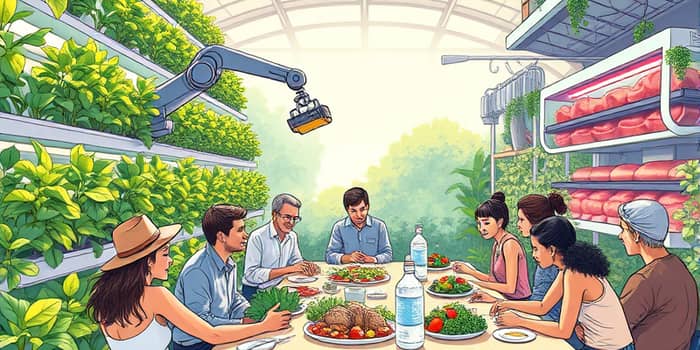
As our world grapples with climate change and population growth, the convergence of technology and food promises a future where sustainability, health, and prosperity go hand in hand. Investors and consumers alike stand at the threshold of a new era in which every bite matters—for our bodies and our planet.
The traditional food system is at a crossroads. With sustainability and health driving a global transformation, innovators are overhauling production, distribution, and consumption models. Food loss and waste alone accounted for 8–10% of all anthropogenic GHG emissions between 2010 and 2016, representing a trillion-dollar annual cost.
Meanwhile, population growth projected to reach 9.8 billion by 2050 and rising incomes exert unprecedented pressure on resources. The challenge is clear: we must feed more people with less environmental impact and higher nutritional value.
The global food tech sector is surging forward, fueled by demand for convenience, transparency, and eco-friendly solutions. In 2024 alone, the market was valued at $205.07 billion, with projections reaching $601.46 billion by 2033 at an impressive 11.6% CAGR.
The Asia Pacific region dominates, commanding nearly one-third of the food tech market. Meanwhile, China’s confectionery and snacks segment alone approaches $1.63 trillion—a testament to both cultural taste and economic power.
Innovation is the engine of transformation. In 2025, industry surveys reveal technology investments are concentrated in areas that boost traceability, efficiency, and cost savings. Yet, cost remains the single biggest hurdle for widespread adoption.
Beyond these pillars, cutting-edge startups are pioneering fermentation technology to create rich flavor concentrates and developing waste-reduction platforms that promise zero-waste and circular food systems.
Consumer preferences are shifting rapidly. Environmental and health concerns drive demand for plant-based, cultivated, and alternative proteins. At the same time, transparency in sourcing and a return to regional supply chains help reduce carbon footprints.
If we can slash the 25–30% of food produced that goes to waste, we will simultaneously cut emissions, bolster food security, and alleviate pressure on water and land resources. These steps form the foundation of eco-efficient and nutritious food systems that benefit communities globally.
Governments worldwide are enacting stricter sustainability guidelines, from cleaner labeling to toxin reduction mandates. These measures not only protect public health but also unlock new market opportunities, propelling technology adoption.
The food tech ecosystem is vast and vibrant: over 2,000 startups, 29,000 companies, and 673,000 patents worldwide. Top hubs include the USA, India, the UK, Canada, and Germany, with London, New York, Singapore, Mumbai, and Melbourne leading investment flows. Online sales, currently at 4.3% of global food revenue, are projected to reach 3,118 billion kilograms by 2028.
Despite the promise, challenges remain. High implementation costs, complex integration with legacy systems, and the need for workforce reskilling can stall progress. Furthermore, consumer and producer habits evolve slowly, complicating waste reduction efforts.
To pave the way forward, stakeholders must collaborate on a menu of solutions: boosting yields per acre with eco-friendly practices, improving post-harvest infrastructure, shifting diets toward less resource-intensive foods, and weaving digital innovations into every link of the supply chain.
The food tech revolution is more than a market trend; it is a call to action. With public–private coordination and bold investments, we can realize a future where clean, abundant, and nutritious food is accessible to all. Investors stand to reap returns not only in financial terms but also in social, environmental, and economic co-benefits that uplift communities worldwide.
As technology reshapes our plates and our planet, each stakeholder—from policymakers to entrepreneurs, from farmers to families—plays a vital role. The journey ahead demands ambition, creativity, and unwavering commitment to sustainability. Together, we can cultivate a thriving ecosystem where innovation meets responsibility, ensuring that our food systems nourish both people and the planet for generations to come.
References













